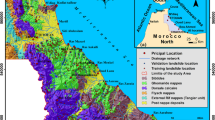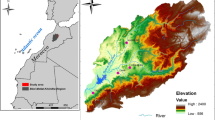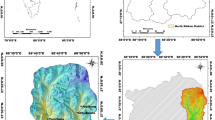Abstract
Landslide is a major threat in the Darjeeling Himalaya within sub-humid climate. Hence proper identification of landslide susceptible zone (LSZ) is very much essential. In this case a multi criterion evaluation approach is applied using thirteen selected indicators. The parameters are categorized into five categories viz. anthropogenic factor, surface causal factor, lithological causal factor, triggering factor and protective factor. Weighted composite model is prepared adopting weighting base as Analytic Hierarchy Process. The obtained result shows that near about 19.92 sq. km (approximately 7.52%) area within the basin is highly susceptible for landslides. High drainage density (avg. 4.31 km/sq. km), relatively steeper slope (>10°) accelerate this process. Beside the main landslide susceptibility layers five separate models of five causal factor groups are prepared and correlated with final LSZ for understanding the priority cluster. Lithological factors cluster appears as a dominant factor group (correlation value 0.95). This LSZ model is also validated by frequency as well as areal density of historical landslides. Beside this, the validation by ROC curve shows 84.00% area under the curve. So, the model can be treated as relevant.





Similar content being viewed by others
References
Moradi, M., Bazyar, M. H., & Mohammadi, Z. (2012). GIS-based landslide susceptibility mapping by AHP method, a case study, Dena City, Iran. Journal of Basic and Applied Scientific Research, 2(7), 6715–6723.
Yilmaz, C., Topal, T., & Suzen, M. L. (2011). GIS-based landslide susceptibility mapping using bivariate statistical analysis in Devrek (Zonguldak-Turkey). Environmental Earth Sciences, 2012(65), 2161–2178.
Eshghabad, S. M., Solaimani, K., & Omidvar, E. (2012). Landslide susceptibility mapping using multiple regression and GIS tools in Tajan Basin, North of Iran. Environment and Natural Resources Research, 2(3), 43–51.
Kumar, R., & Anbalagan, R. (2015). Landslide susceptibility zonation of Tehri reservoir rim region using binary logistic regression model. Current Science, 108(9), 1662–1672.
Pradhan, B., Sezer, E. A., Gokceoglu, C., & Buchroithner, M. F. (2010). Landslide susceptibility mapping by neuro-fuzzy approach in a landslide-prone area (Cameron Highlands, Malaysia). IEEE Transactions on Geoscience and Remote Sensing, 48(12), 4164–4177.
Pascale, S., Parisi, S., Mancini, A., & Schiattarella, M. (2013). Landslide susceptibility mapping using artificial neural network in the urban area of Senise and San Costantino Albanese (Basilicata, Southern Italy). In: ICCSA, part IV, LNCS 7974, pp. 473–488.
Saaty, T. L. (1980). The analytical hierarchy process. New York: McGraw Hill.
Ayalew, L., Yamagishi, H., Marui, H., & Kanno, T. (2005). Landslides in Sado Island of Japan: Part II. GIS-based susceptibility mapping with comparisons of results from two methods and verifications. Engineering Geology, 81, 432–445.
Official Website of Government of Darjeeling. www.darjeeling.gov.in/geography.html.
Rai, P. K., Mohan, K., & Kumra, V. K. (2014). Landslide hazard and its mapping using remote sensing and GIS. Journal of Scientific Research, Banaras Hindu University, Varanasi, 58: 1.
Pal, S. (2016). Identification of soil erosion vulnerable areas in Chandrabhaga river basin: A multi-criteria decision approach. Modeling Earth Systems and Environment, 2(5), 1–11.
Achour, Y., Boumezbeur, A., Hadji, R., Chouabbi, A., Cavaleiro, V., & Bendaoud, E. A. (2017). Landslide susceptibility mapping using analytic hierarchy process and information value methods along a highway road section in Constantine, Algeria. Arabian Journal of Geosciences, 10, 1–16. doi:10.1007/s12517-017-2980-6.
Eastman, J. R. (2006). Idrisiandes: tutorial, clark labs. Worcester: Clark University.
Elmahdy, S. I., Marghany, M. M., & Mohamed, M. M. (2014). Application of a weighted spatial probability model in GIS to analyse landslides in Penang Island, Malaysia. Geomatics, Natural Hazards and Risk, 7:1, Taylor and Francis Group. pp. 353–356. doi: 10.1080/19475705.2014.904825.
Paul, P. K., & Das, S. (2014). Landslide susceptibility evaluation of GIT watershed of Kalimpong subdivision, India using information value method. International Journal of Economic and Environment Geology, 5(2), 18–24.
Chauhan, S., Sharma, M., Arora, M. K., & Gupta, N. K. (2010). Landslide susceptibility zonation through ratings derived from artificial neural network. International Journal of Applied Earth Observation and Geoinformation, 12, 340–350.
Gokceoglu, C., & Aksoy, H. (1996). Landslide susceptibility mapping of the slopes in the residual soils of the Mengen region (Turkey) by deterministic stability analyses and image processing techniques. EngGeol, 44, 147–161.
Mandal, S., & Maiti, R. (2014). Role of lithological composition and lineaments in landsliding: A case study of Shivkhola watershed, Darjeeling Himalaya. International Journal of Geology, Earth and Environmental Sciences, 4(1), 126–132.
Biswas, S. S., & Pal, R. (2016). Causes of landslides in Darjeeling Himalayas during June–July, 2015. Journal of Geography and Natural Disasters, 6, 173. doi:10.4172/2167-0587.1000173.
Dahal, R. K., & Hasegawa, S. (2008). Representative rainfall thresholds for landslides in the Nepal Himalaya. Geomorphology, 100, 429–443. doi:10.1016/j.geomorph.2008.01.014.
Basu, T. & Pal, S. (2017). Identification of landslide susceptibility zones in Gish River basin, West Bengal, India. Georisk, Taylor & Francis. pp. 1–16. DOI: 10.1080/17499518.2017.1343482.
Arbanas, Z., & Dugonjić, S. (2010). Landslide risk increasing caused by highway construction. Researchgate, pp. 333-342.
Mandal, B., & Mandal, S. (2016). Assessment of mountain slope instability in the Lish River basin of Eastern Darjeeling Himalaya using frequency ratio model (FRM). Modeling Earth Systems and Environment, 2, 1–14.
Rasyid, A. R., Bhandary, N. P., & Ryuichi, Y. (2016). Performance of frequency ratio and logistic regression model in creating GIS based landslides susceptibility map at Lompobattang Mountain, Indonesia. Geoenvironmental Disasters, 3(19), 12.
Ansari, Md A, Khan, P. K., Tiwari, V. M., & Banerjee, J. (2014). Gravity anomalies, flexure, and deformation of the converging Indian lithosphere in Nepal and Sikkim-Darjeeling Himalayas. International Journal of Earth Sciences (GeolRundsch), 103, 1681–1697.
Ghosh, K. G., & Saha, S. (2015). Identification of soil erosion susceptible areas in Hinglo River Basin, Eastern India based on geo-statistics. Universal Journal of Environmental Research and Technology, 5(3), 4–5.
Hadley, R. F., & Schumm, S. A. (1961). Sediment sources and drainage basin characteristics in upper Cheyenne River Basin. US geol survey water supply paper 1531-B:198.
Strahler, A. N. (1964). Quantitative geomorphology of drainage basins and channelnetworks. In V. T. Chow (Ed.), Handbook of applied hydrology (pp. 411–476). New York: McGraw-Hill.
Nag, S. K. (1998). Morphometric analysis using remote sensing techniques in the Chaka sub-basin, Purulia district, West Bengal. Journal of the Indian Society of Remote Sensing, 26(1), 69–76.
Simon, N., Roslee, R., Marto, N. L., Akhir, J. M., Rafek, A. G., & Lai, G. T. (2014). Lineaments and their association with landslide occurrences along the Ranau-Tambunan Road, Sabah. EJGE, 19, 645–655.
Kitutu, M. G., Muwanga, A., Poesen, J., & Deckers, J. A. (2009). Influence of soil properties on landslide occurrences in Bududa district, Eastern Uganda. African Journal of Agricultural Research, 4(7), 611–620.
Reichenbach, P., Busca, C., Mondini, A. C., & Rossi, M. (2014). The influence of land use change on landslide susceptibility zonation: The Briga catchment test site (Messina, Italy). Environmental Management, 54, 1372–1384.
Iwahashi, J., Okatani, T., Nakano, T., Koarai, M., & Otoi, K. (2014). Landslide susceptibility analysis by terrain and vegetation attributes derived from pre-event LiDAR data: A case study of granitic mountain slopes in Hofu, Japan. INTERPRAEVENT2014 in the Pacific Rim November 25–28, 2014, in Nara, Japan.
Kamp, U., Growley, B. J., Khattak, G. A., & Owen, L. A. (2008). GIS-based landslide susceptibility mapping for the 2005 Kashmir earthquake region. Geomorphology, 101, 631–642.
Omosanya, K. O., Mosuro, G. O., Laniyan, T. A., & Ogunleye, D. (2012). Prediction of gravity anomaly from calculated densities of rocks. Advances in Applied Science Research, 3(4), 2059–2068.
Author information
Authors and Affiliations
Corresponding author
Electronic supplementary material
Below is the link to the electronic supplementary material.
Rights and permissions
About this article
Cite this article
Basu, T., Pal, S. Exploring landslide susceptible zones by analytic hierarchy process (AHP) for the Gish River Basin, West Bengal, India. Spat. Inf. Res. 25, 665–675 (2017). https://doi.org/10.1007/s41324-017-0134-2
Received:
Revised:
Accepted:
Published:
Issue Date:
DOI: https://doi.org/10.1007/s41324-017-0134-2




